Operational excellence
Excellence in operations is the key to having a competitive advantage in many markets. Having a good level of service, quality or cost adjustments depends on the efficiency and effectiveness of the operations.
However, today, it has become an even bigger challenge if we keep in mind the current changing environment that affects both production models and the customer behavior.
DOT Consulting support our clients to achieve operational excellence throughout the value chain: from of R&D of product or service design, production, logistics, maintenance, sales and customer service, administration and corporate services. Our goal is for our customers to improve their agility and efficiency at every stage of the value chain to stay competitive.

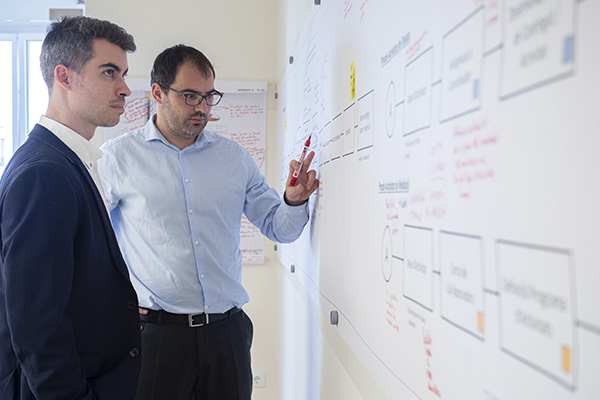
The success of our customers is our goal. we are fully focused on the tangibility of our results through our change and transformation management methodology.
Achieving a competitive advantage must be lasting and therefore must be assumed by the entire organization.
DOT Consulting's change and transformation management methodology is based on the participation of our clients' staff. and the support throughout the transformation process by our teams of consultants with the aim of having an appropriation of the solution.
diagnosis
actions to improve and quantify
potential economic profitability
and change
management project
improvement and continuous
evaluation of expected results
for consolidation
monitoring of the actions
implemented
- The reliability and availability of the equipment have a direct impact on both the capacity and the quality of the production. And the maintenance management strategy has a lot to say.
- Starting from variance-based maintenance, organizations need to evolve toward a mature risk management model.
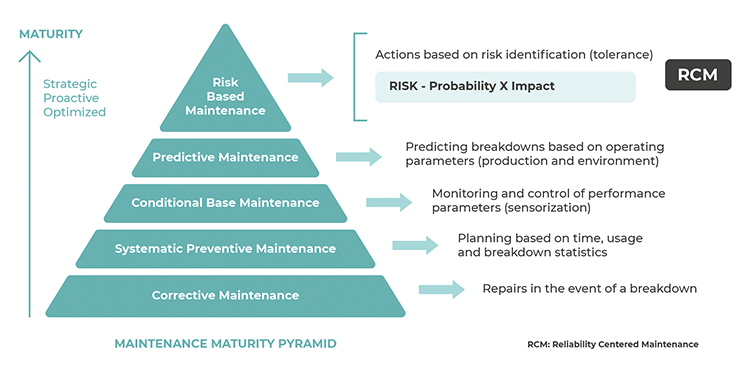
- The most mature maintenance management strategy is RCM (Reliability Centered Maintenance) or Reliability Centered Maintenance or Reliability, whose systematic, reasoned and documented methodology allows the development and optimization of the Preventive Maintenance Plan of a facility. Let's get to work together
- RCM is an appropriate maintenance management approach to controlling the risk of equipment failure and contributes to:
- Increase system reliability or install by improving maintenance.
- Reduce maintenance costs (on maintenance).
- Strengthen (or implement) continuous improvement in maintenance.
- Contribute to the implementation of the management of the activity based on the ISO 55000 standard.
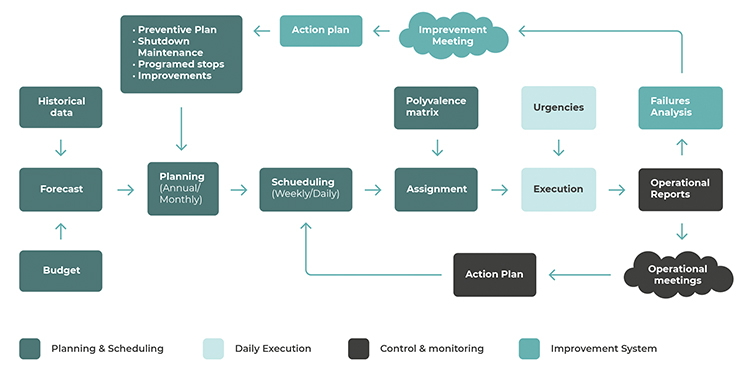
- Maintenance processes: planning of materials and preparation of works, prioritization of works according to risks and impact, execution and supervision of corrective / preventive / predictive maintenance or certification of works.
- Organization: from the assignment of functions and roles, the breadth of optimal control, the coordination between the productive areas and the areas of support or control and monitoring of the external maintenance teams.
- Training of teams: technical profiles and maintenance orders, training of teams, versatility between specialists or available training plans.
- Chemical industry
- Aeronautical maintenance
- Manufacturing industry
- Manufacture of capital goods
- Pharmaceutical industry
- Building maintenance
- Maintenance of large facilities
- RCM Reliability Centered Maintenance
- Improving maintenance efficiency
- Improving the quality of maintenance processes (FTT: First Time Through)
- Management and optimization of stocks and spare parts
- Maintenance outsourcing: contracting and control of subcontractors.
- Risk Management for job planning and prioritization
- Shutdown planning and management
- Selection and implementation of maintenance management programs (CMMS)
- An inefficient supply chain can cause damage customer service, loss of sales, excessive inventories and all kinds of extra costs such as transportation, investments unnecessary or obsolescence of stocks. Let's get to work together
- Each market and product has its own particular characteristics and the solutions must be adapted to each case and in agreement with the sector where the companies are located.
- However, it can be stated that in any sector, having an efficient supply chain provides great competitive advantages:
- Greater customer satisfaction and credibility of the company
- Increased sales
- Decreased stocks and increased turnover
- More efficient use of productive capacity
- Greater visibility for investment in productive assets
- Reduction in additional costs along the entire chain supply
- Better financial management of operations
- Greater knowledge of the demand and consequently of the market
- It is common to get improvements above 30 pp. At the service level and a 20% decrease in the stock level.
- The diagnosis phase allows us to identify opportunities improvement along the entire supply chain: from the delivery time review to forecast systems or inventory management.
- The diagnosis must allow us to identify the root causes that generate inefficiencies and determine both the potential for improvement and its economic impacts, as well as the definition of an action plan to address its implementation.
- Implementing improvements in a supply chain is especially critical as many people, departments, interests and even different countries are involved. Transversal changes need to be coordinated and implemented in different disciplines, such as the commercial, production, logistics, planning or purchasing areas.
- Main lines of action regarding management of the supply chain:
- Supplier management and integration
- Supply chain traceability and monitoring
- Reverse logistics: return management
- 4.0 forecasting systems
- Production capacity management vs. demand
- Production planning
- Inventory management (stocks)
- Management by SLA s (Service Level Agreement)
- Process automation and optimization: routes of transport, automated warehouses or displacement of goods
- Digitization of supply and purchasing strengthens the consistency and rigor of the process. However, this digitization must be based on an agile process and one clear flow of information that complies with policies strategic and operational aspects of the company.
- An orderly and optimized purchasing process has an impact directly outside the company and can become, in addition, in a competitive advantage to the sector.

- Purchasing operations see increased complexity when more transparency is needed and processes are established tender or tenders. Public administrations and Organizations with a high degree of compliance are more accustomed to this bidding operation which involves a larger number of departments and carries the risk of becoming a cumbersome and cumbersome process.
- A key definition of the process, which is known to the entire organization, determines optimal but realistic deadlines for each phase of the process, and is planned appropriately and in sufficient time to make the process deadlines, product requirements clear. or serve the objective and non-objective criteria of bid evaluation.
Bidding process
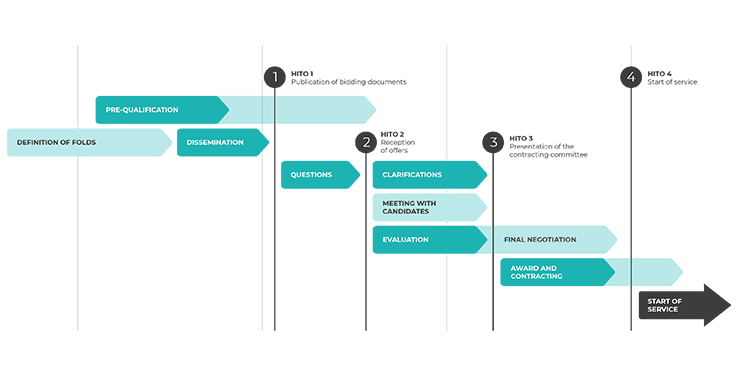
- Establish a calendar shared by the organization
- Consensus on process flow of bidding
- Determination of control points process progress
- Definition of needs and requirements in which you can participate some actors of the market
- Definition of the criteria for bid evaluation and scoring
- Preparation of technical specifications, administrative and legal
- Pre-qualification of suppliers (pre selection) based on defined requirements
- Formal invitation to suppliers and description of the main ones fold values
- Period of clarifications on the bids with the aim of receiving optimal offers
- Receipt and evaluation of offers a based on objective and qualitative criteria
- Round of clarifications of the offers and extension of information
- Evaluation and scoring of the offers received
- Final assessment by the Committee of recruitment
- The processes of transformation of models purchasing operations are not easy or fast.
- Many times, companies are looking for solutions specific problems without taking into account the effects that these changes may have upstream and downstream of the process. You need to have a holistic view of the process and have take into account the daily experience of all users of the process.
- When this global vision does not have or does not value the ability of the users, it is common to find ourselves with tasks and subprocesses that are performed outside the established circuits with the consequent loss of control and process visibility.
- The DOT Consulting methodology considers these critical aspects and, together with the key people of the organization, we proceed to identify the main opportunities of the current operation as well as the visualization of the potential offered by the optimization, automation and digitization of all process.
- These processes of change and transformation are often complex and it is easy to lose sight of the medium-term goals if the long-term goals are not clear.
- The collaboration with the actors of the process continues with its participation in the design of the new operation. Employees will be the users of the new operation and must participate in the transformation process, both in the long-term vision and in the identification of opportunities for improvement or in the design of the solution. Only then will they feel part of the solution and the changes they will be assimilated much faster.
- At DOT Consulting, we design and implement models operating operations with high economic impact both a at reducing costs of goods acquired as the optimization of resources used:
- Categorization and standardization of products and services
- Optimization and approval of suppliers
- Models of tenders and competitions
- Contract and SLA Management
- Model of government: functions, roles and leaders
- Procurement forecasting and planning models and shopping
- Decentralization of purchases
- Monitoring and control: data and analytics
- Automation Sustainable development of strategic suppliers 4.0 shopping: RPA, BPM, AI and systems integration with ERP
- From a potential commercial expansion thanks to the greater competitiveness of the product or service to a greater capacity of investment in R + D + I, equipment or facilities.
- However, it is necessary to consider the most appropriate strategy taking into account the situation of the companies and their environment: specific actions in the form of shock plans or the establishment of mechanisms that allow the control and continuous optimization of costs. Let's get to work together
Cost structure
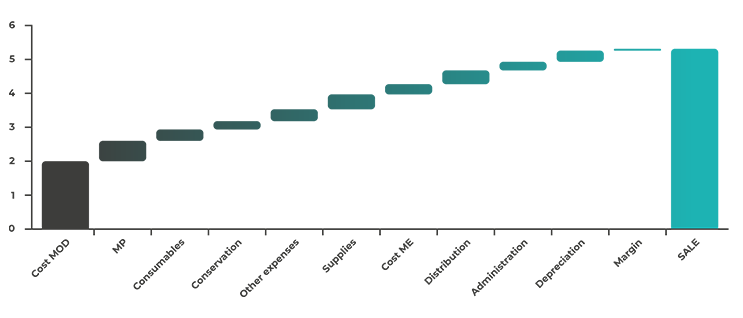
- To reduce the level of costs operating sustainably, it is necessary to make a suitable one cross-sectional analysis with the aim of determine the weight and impact of each one of the items that make up the production processes. Special attention to the interaction between areas, to resource management within an area and opportunity costs lost.
- Once you are aware of the product cost structure or service, a plan must be defined innovative action that allows the necessary cost adjustments. The plan for the restructuring of costs should be projected in the short term, medium or long term depending on the potential impacts and feasibility of actions.
- At the same time, it is necessary to establish control mechanisms that provide visibility on the breaches and disagreements and facilitate the control of deviations with respect to standards.
- At DOT Consulting we help identify the actual costs of our customers' products and services and we determine potential savings with the goal of designing and implementing an action plan that allows a sustainable reduction in its cost structure:
- Task digitization through innovative solutions 4.0
- Task automation using RPA solutions
- Elimination of activities that do not add value or duplication of tasks
- Suppression of reprocessed for quality issues
- Processes read by eliminating overprocesses that do not add value to the customer or product
- Workload balancing and optimal resource planning
- Inventory and supply chain management
- That's when we talk about Lean Management, Lean Services or even Lean Start ups.
- In any of these areas, Lean is a methodology of work whose mission is to change the way we work in order to eliminate waste or activities that do not they add value and establish a work dynamic that allows the improvement continues. Let's get to work together
Worthless activities
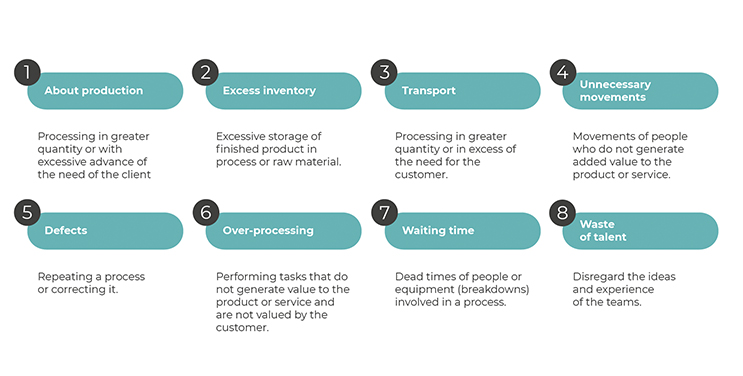
- At DOT Consulting, we put all our efforts into implementing LEAN techniques and transforming our way of working. It is only possible when teams adopt and internalize these techniques.
- That is why we put a lot of effort into working with them, training them in each concept, resolving their doubts, to judging and motivating teams as well as looking a demonstration effect on each of the tools and dynamics implemented.
- TPM: Total Productive Maintenance
- SMED: Single Minute Exchange of Die
- VSM: Value Stream Mapping
- 5S: Seiri, Seiron, Seiso, Shitsuke y Seiketsu
- Kaizen: ideas for continuous improvement
- Kanban: pull rod systems
- Visual Factory
- Root cause analysis
- Team Management Dynamics (GAPs)